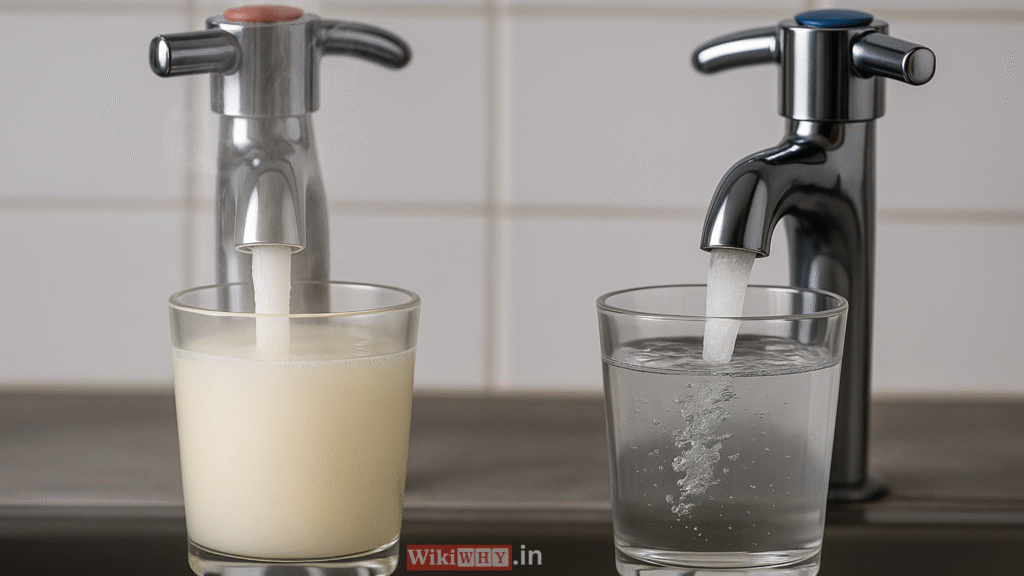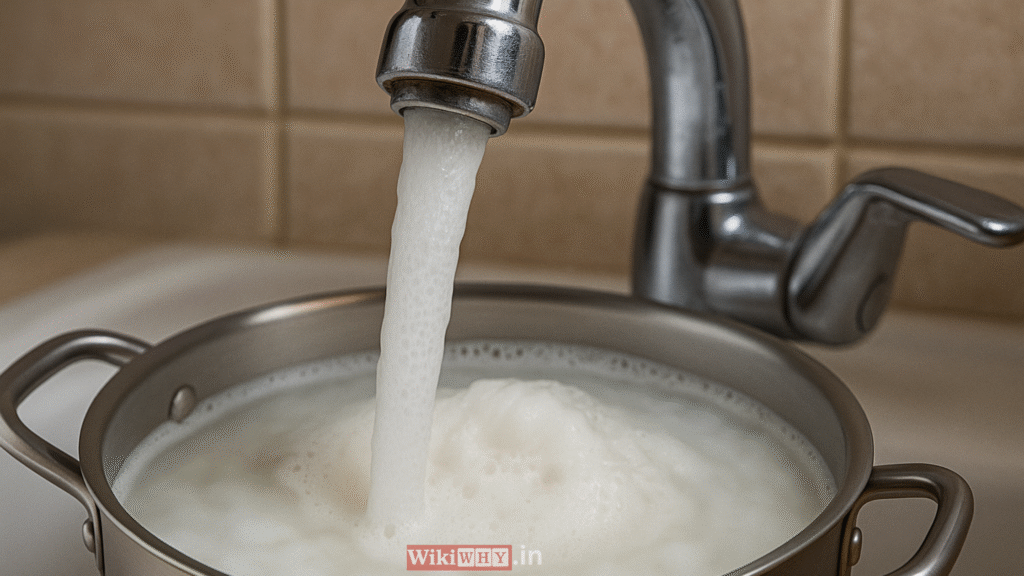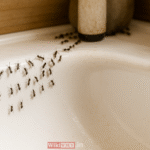One morning, you turn on your hot water tap and expect hot and clean water for a fresh bath. But cloudy, milky water is streaming out.
This sometimes brings confusion to your mind about whether it is safe to use this water. Actually, in almost all cases, it is safe and more common than you think.
Funny story—It was last winter. I wanted to have my morning tea. I turned on my hot water tap and noticed my hot water looked like a foggy mess. For a split second, I thought my faucet had turned into a smoke machine. But within seconds, the water cleared up. It was just tiny air bubbles doing their thing.
That strange moment got me curious, so I started digging into the topic.
After looking into it deeply, here’s what I found. Cloudy hot water is usually harmless, but sometimes it can signal something more serious.
Let’s clear things up.
Is Milky Hot Water Normal?
The answer is, in almost all cases, it is normal.
Often when hot water appears cloudy or milky, all it may be is just air bubbles. When we heat tap water, it releases dissolved gases, primarily oxygen.
This is seen as the air bubbles join together in a variety of small bubbles—this is what we see when the water looks cloudy or milky. But they disappear quickly if it is a normal case.
Quick tip: Fill a glass with hot water and let it sit. If the cloudiness clears from the bottom up within 30–60 seconds, it’s likely just air.
But what if it doesn’t clear? Or smells bad? Then you may have something else going on. Here’s a quick chart to help decode the signs:
| What You See | Reason | Should You Worry? |
|---|---|---|
| Cloudy water clears in seconds | Air bubbles | No, it’s normal |
| Rotten egg smell | Bacteria in heater | Yes, call a plumber |
| Cloudy + gritty or sandy texture | Sediment buildup | Yes, flush the heater |
| White, chalky look | Hard water | No, but softener helps |
| Only hot water is cloudy | Heating issue | Usually harmless |
What Makes Hot Water Cloudy?
Let’s break down the most common causes one by one.
1. Air Bubbles: The Most Common Culprit
Almost in all cases, these air bubbles are the main reason for hot, cloudy water.
Water eliminates its dissolved gases when it reaches elevated temperatures. The tap water produces white or cloudy effects because these gases create small bubbles which rise through the water when you turn on the tap.
How to test it:
- Fill a glass with hot water
- Let it sit for 30–60 seconds
- If it clears from the bottom up, it’s just air—totally harmless
This is especially common in winter, when cold groundwater contains more oxygen. Heating that water releases more bubbles.
✅ Good news: No fix needed.
2. Sediment in the Water Heater
Mostly in old heaters, the bottom of the tank is filled with sediments like materials due to minerals and dirt in water. These sediments mix with hot water when you try to draw hot water.
This gives the water a milky or white look. But in this case, the white look doesn’t disappear even after several minutes, unlike the previous case.
Look out for:
- Persistent cloudiness
- Popping or rumbling noises from the heater
- Lower hot water pressure
Fix it:
- Flush your water heater
⏳ Time to act: Yearly flushing helps prevent long-term issues.
3. Hard Water Minerals
The water in regions with hard water contains elevated quantities of calcium and magnesium. The minerals become apparent when heated, which results in white or cloudy water.
DIY test:
- Boil a glass of tap water
- If a white ring forms around the edge, your water is hard
Solution:
- Install a water softener
- Or use a whole-house filter
💡 Bonus: As compared to hard water, soft water is better for your skin, hair, appliances, and even your laundry.
4. Aging or Rusty Water Heater
Water heaters don’t last forever. Corrosion can break down the tank lining, releasing rusty particles into your water.
Warning signs:
- Metallic taste
- Rusty or discolored hot water
- Hot water temperature fluctuates
What to do:
- Call a plumber
- You have to change the anode rod along with the whole unit when it surpasses ten years of service.
⚠️ Remember: An old heater can waste energy and become a safety risk.
5. Old or Corroded Pipes
Still have old galvanized steel pipes? Corrosion could be entering your water.
Signs of trouble:
- Brownish or orangey water
- Grit or flakes in the water
- Lower water pressure
A permanent solution: Pipe problems involve installing PEX or copper pipes instead of worn-out ones.
Use a filter in the meantime
🛠️ Heads-up: Pipe replacement is an investment—but it pays off in water quality and peace of mind.
Why Is Only My Hot Water Cloudy But Cold Water Clear?

If your cold water is crystal clear but your hot water is murky, the issue is most likely your water heater.
Here’s why:
- Hot water holds more air than cold, so it releases more bubbles
- Heating triggers chemical reactions not found in cold water
- Hot water passing through a pipeline will start the sediment in the water, but cold water movement will not cause any disturbance to the sediment
A person should understand that the issue arises from temperature changes in the water instead of their plumbing system.
Cloudy and White Hot Water: Should You Worry?
A milky or white appearance in hot water usually means:
- Harmless air bubbles
- Hard water minerals becoming more visible
- Very rarely, plastic particles from degraded plumbing
As a test, Fill a glass with water and allow it to rest. Usually, a clear upward movement starting from the bottom indicates that your water is likely safe for drinking.
The water remains unclear while producing unusual odors or flavors, so continue reading.
How to Fix Cloudy Hot Water
Now that you know the causes, let’s fix them. Most of these are easy DIY jobs.
1. Do the Glass Test
Still unsure if it’s just air?
- Fill a clear glass with hot water
- Wait 30–60 seconds
- Watch for the cloudiness to fade from the bottom up
✅ Clears up? You’re good.
⛔ Still cloudy? Try flushing the heater next.
2. Flush Your Water Heater
This removes sediment and mineral buildup inside the tank.
You’ll need:
- Garden hose
- A bit of time
Steps to flush:
- Turn off the heater
- Let it cool down
- Connect hose to the drain valve
- Open valve and drain a few gallons
- Close valve and restart the system
💧 Tip: Drain until the water runs clear.
3. Install a Water Softener or Filter
If you are experiencing hard water mineral deposits, a softener can prevent the cloudiness, protect your heater from being ruptured, and protect sinks and appliances from staining.
Added perks:
- Better soap lather
- Shinier glassware
- Softer skin and hair
🛠️ Filters can also trap rust and sediments from pipes.
4. Replace Old Equipment
If your water heater is 10–15 years old and showing signs of wear, it’s time to upgrade.
New models are:
- More energy-efficient
- Safer
- More reliable for leaks or corrosion
🚗 It’s like owning a car—there’s no way you’re trusting a 20-year-old engine to take you places.
5. Call a Plumber When in Doubt
If you’ve done everything you can and your water still looks funny—or smells or tastes funny—it is time to call a pro.
🔧 A licensed plumber can:
- Check for bacterial contamination
- Inspect plumbing for corrosion
- Test heater parts and water quality
Red Flags That Need Immediate Attenti
At times, cloudiness in water indicates a problem which extends beyond dissolved minerals or trapped air. Watch for these warning signs:
- Smells like rotten eggs
- Grit or sand in water
- Water doesn’t clear at all
- Strange taste
- Both hot and cold water are cloudy
⚠️ Don’t neglect these. Call a pro immediately.
How to Avoid Cloudy Hot Water Down the Road
Maintenance keeps you from getting cloudy water—and expensive repairs.
Try this:
- Flush your water heater every 6–12 months
- Install filters or softeners if you have hard water
- Replace outdated plumbing before it becomes a larger issue
- Schedule regular inspections to recognize issues sooner
🪥 Think of it as oral care for your home’s water system.
Final Thoughts
Milky hot water is usually not dangerous in most instances and is usually due to the air or minerals dissolving in the water.
However, if it changes in taste, smell, or does not dissipate, then it is best to further investigate the issue.
Most plumbing issues can be resolved without too much effort or money, and these issues can often be fixed with simple investigation.
Be more cautious and conduct tests in advance and eliminate potential issues.
In the end, here’s to a life free from plumbing surprises!
Let’s hope your hot water stays clean and you don’t have any plumbing troubles!
Frequently Asked Questions(FAQs)
👉 Also check: If Your Heater Blowing Cold Air? — Learn why it happens and how to fix it before calling a technician.













